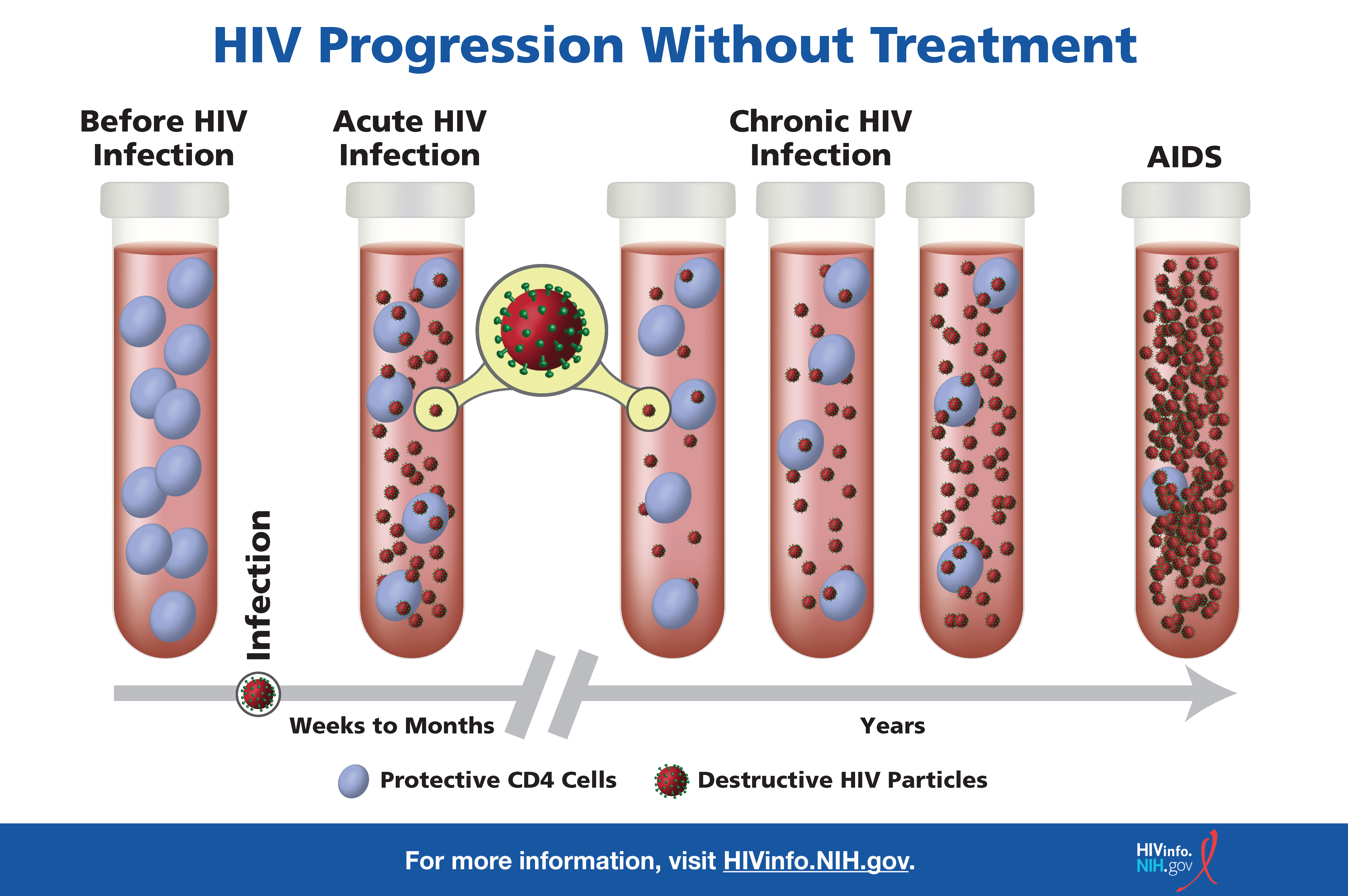The Stages of HIV Infection
Key Points
- Without treatment using HIV medicines, HIV infection advances in stages, getting worse over time.
- The three stages of HIV infection are (1) acute HIV infection, (2) chronic HIV infection, and (3) acquired immunodeficiency syndrome (AIDS).
- There is no cure for HIV, but treatment with HIV medicines can slow or prevent HIV from advancing from one stage to the next, allowing people with HIV to live long, healthy lives.
HIV Infection
Without treatment, HIV infection gets progressively worse over time as the virus destroys key components of the immune system. Prolonged exposure to untreated HIV can eventually cause acquired immunodeficiency syndrome (AIDS).
There is no cure for HIV, but there is good news. Treatment with HIV medicines (called antiretroviral therapy or ART) can slow or prevent HIV from progressing into more serious forms. HIV medicines help people with HIV live long, healthy lives.
Research shows that people who start HIV treatment early can live as long as people who do not have the virus, largely due to the advancement of HIV medicines.
Stages of HIV Infection
The progression of HIV occurs in three stages over time (months and years) in people who don’t receive treatment. The stages of HIV infection include:
Acute HIV Infection
Acute HIV infection is the earliest stage of HIV infection, and it generally develops within 2 to 4 weeks after infection with HIV. During this time, some people have flu-like symptoms, such as fever, headache, and rash. In the acute stage of infection, HIV multiplies rapidly and spreads throughout the body, attacking and destroying the infection-fighting CD4 cells (CD4 T lymphocytes) of the immune system. During this stage, the level of HIV in the blood is very high, which greatly increases the risk of HIV transmission.
Chronic HIV Infection
The second stage of HIV infection is chronic HIV infection (also called asymptomatic HIV infection or clinical latency). During this stage, HIV continues to multiply in the body but at very low levels. People with chronic HIV infection may not have any HIV-related symptoms. Without ART, chronic HIV infection usually advances to AIDS in 10 years or longer, though in some people it may advance faster. People who are taking ART may be in this stage for several decades.
AIDS
AIDS is the final, most severe stage of HIV infection, and causes severe damage to the immune system. As a result, the body cannot fight off opportunistic infections, also called AIDS-defining conditions. People with HIV are diagnosed with AIDS if they have a CD4 count of less than 200 cells/mm3 or if they have certain opportunistic infections. Once HIV progresses to the AIDS stage, a person can have a high viral load and transmit HIV to others very easily. Without treatment, people with AIDS typically survive about 3 years.

The image above depicts what happens in the blood of people with HIV throughout the stages of HIV infection. Without treatment, HIV slowly increases in number and attacks and destroys normal CD4 cells. A lack of CD4 cells severely limits the immune system’s ability to fight off other infections.
Can HIV be treated at different stages?
ART is very effective at reducing viral load to undetectable levels, particularly when started as early as possible during acute infection. Research trials found that there was a 53% reduction in the risk of death or serious illness if treatment was started with a high CD4 cell count.
People with chronic HIV infection may still transmit HIV to others; however, people who take ART exactly as prescribed and maintain an undetectable viral load during this stage have minimal risk of transmitting HIV to someone without HIV through sex.
Even if someone’s HIV progresses to AIDS, HIV medicines can still reduce the amount of HIV virus in the blood to undetectable levels, allowing more CD4 cells to regenerate. In turn, people taking these medicines will be less likely to acquire an opportunistic infection, despite an AIDS diagnosis.
Ultimately, virtually anyone with HIV can benefit from modern HIV medicines, regardless of what stage of HIV they are in.
How can I prevent HIV from progressing through the stages?
Once a person is diagnosed with HIV, they should start ART as soon as possible. One of the main goals of ART is to reduce a person's viral load to an undetectable level. People with HIV who maintain an undetectable viral load have effectively no risk of transmitting HIV to someone without HIV during sex and should maintain relatively normal immune function.
In addition, the Centers for Disease Control and Prevention suggests that having an undetectable viral load likely reduces the risk of HIV transmission through sharing of needles, syringes, or other drug injection equipment (such as cookers), but are unsure how much the risk is reduced.
Importantly, ART is only highly effective if taken exactly as prescribed. To ensure that HIV does not progress to more advanced stages, it is important to adhere to your prescribed medication schedule. In some cases, those who do not adhere to an ART schedule can develop resistance to their HIV medicines, making them ineffective.
Some people face challenges that make it hard to stick to a treatment plan and maintain an undetectable viral load. In this case, they should encourage their partners to take pre-exposure prophylaxis (PrEP). PrEP is medicine that people without HIV can take to prevent HIV infection, even if they get exposed to the virus.
This fact sheet is based on information from the following sources:
From HIV.gov:
From the Centers for Disease Control and Prevention (CDC):
Also see the HIV Source collection of HIV links and resources.
